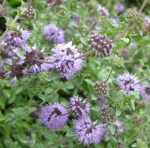
Native to Europe, North Afrcia, and the Middle East, this herbaceous perennial is also known as pennyrile, hillwort, brotherwort, run-by-the-ground, lurk-in-the-ditch, pudding grass, and pulegium. It is a member of the mint family, Lamiaceae, that also includes rosemary, beebalm, and ajuga. American pennyroyal (Hedeoma pulegioides) is in the same family as the European kind but not in the same genus although the two species share a number of characterisitics. European pennyroyal grows up to 1′ tall and has square stems and elliptical to obvate leaves with smooth or slightly toothed margins. The leaves are about 1/2″ long and are covered with fine hairs. In late summer, whorls of two-lipped, bluish lilac, 1/4″ long flowers appear in the leaf axils. European pennyroyal has been known from ancient Greek and Roman times and has been used medicinally, as a pest repellent, and to flavor food. Pennyroyal oil is toxic to both animals and humans and should be used with extreme caution. The genus name, Mentha, honors the Greek water nymph who was transformed by Persephone into a mint plant as revenge for the nymph’s affair with Persephone’ s husband, Hades. The specific epithet, pulegium, comes from the Latin word, pulex, meaning flea and refers to its pest repelling qualities.
Type: Herbaceous perennial
Bloom: Axial whorls of small bluish lilac flowers in late summer.
Size: 1′ H
Light: Full sun to partial shade
Soil: Fertile, medium m oist, well-drained
Hardiness: Zones 6-9
Care: Low maintenance
Pests and Diseases: None of signficiance
Propagation: Seed, stem cuttings, division
Companion Plants: Other herbs that like sun and medium moist soil like basil, parsley, and chives
Photo Credit: Raffi Kojian Gardenology.org